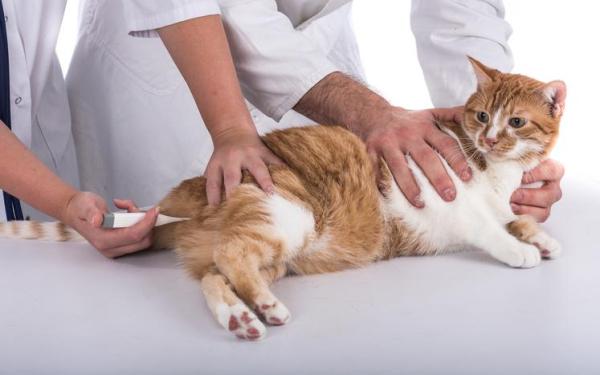
Taking a cat's temperature is not something you will necessarily need to do a lot. If we are going to share our life with a cat, it is still an important thing to know. This could be in case we see them acting differently or suspect they may be showing symptoms of disease. Fever is a common symptom for many diseases in cats. By measuring a cat's temperature, we can see if it might be time to take our cat to the vet. Equally, when a cat's temperature is too low, their well-being is also threatened.
At AnimalWised we explain how to take a cat's temperature. We also provide important information on normal cat body temperature and cat fever. Knowing this information will help you distinguish between a healthy cat and a sick one.
Normal body temperature of a cat
Before explaining how to measure a cat's temperature, we need to know its normal level. By contrasting the reading with a cat's normal body temperature we can interpret it in terms of health. Although smaller mammals than humans, cats have a higher body temperature which oscillates somewhere between 38 ºC and 39.2 ºC/100.4 ºF and 102.5 ºF.
It is important to note the difference between adult cats and kittens. A kitten's body temperature is lower. At birth, they are unable to control their body temperature, a function which only develops with age. This is why mother cats need to keep newborn kittens close and conserve body heat. For a kitten, a body temperature of 37 ºC/98.6 ºF is not abnormal. If an adult cat has the same body temperature, they will be considered hypothermic and will need to see a vet.

Ideal ambient temperature for cats
Although cats and humans have different body temperatures, they should feel comfortable in similar ambient room temperatures. As we may do, cats will look for warmer places to stay in the home during cold seasons. This is why accessories like cat hammocks have grown in popularity because you can suspend them over radiators.
We need to keep ambient temperature and heat sources in mind. If a cat has been resting near a fire or radiator, it is possible their reading will be higher than 39.2 ºC/102.5 ºF. This doesn't mean they have a fever, but have simply been warmed up by the radiated heat.
In warmer seasons when temperatures rise, cat temperature readings can be affected also. The cat may suffer from heat stroke if they are unable to stay in cool or shady places. On very warm days, you may see them laying on tiled floors or even in bathtubs to cool down. If a cat is breathing with their mouth open, then they are overheated. You will need to take them to a veterinarian as heat exhaustion can be fatal.
High temperature in cats
We will explain how to take a cat's temperature below, but first we want to discuss high and low temperatures in felines. When a cat has a high temperature, they have something called hyperthermia. Cat fever will result in an elevated body temperature, i.e. hyperthermia. However, hyperthermia has different causes and a fever is only one of them. Causes of hyperthermia in cats include:
- Fever: also known as pyrexia, a fever is an elevated temperature caused by sickness. This sickness could be an infestation, infection or other medical condition.
- Exertion: if they have exercised a lot, especially when the ambient temperature is warm, cat body temperature can rise. It will usually fall soon after exercise ceases.
- Heat dissipation: if the cat has a problem getting rid of heat due to a thermoregulation problem, the result will be an increased body temperature.
- Drugs: medication or other drugs can cause a raised temperature as a side effect. Poisoning can also do the same.
If you worry your cat has a fever, heat stroke or any problematic temperature increase, you should also look for other symptoms. This will help you to work out the reason for the increase. Whatever the cause, however, you will need to take the cat to the vet for an adequate diagnosis.

Low temperature in cats
Although cat fever is more often discussed, a low body temperature in cats is also problematic. When a cat has a lowered body temperature, it is known as hypothermia. Like hyperthermia, hypothermia also has various causes. These may include:
- Being submersed in very cold water
- Cold shock
- Low ambient temperature
- Medical conditions such as hyperthyroidism
The risk of hypothermia is greater in young kittens and senior cats. Their problems with thermoregulation means they are more susceptible to harm when temperatures are low. When cats suffer hypothermia, the body eats up its energy reserves and metabolism is reduced. The body's function can be so impaired that the cat's heart stops.
How to take a cat's temperature?
The only appropriate way to measure a cat's temperature is using a thermometer. The type of thermometer we use should be a digital one, something we'll explain further below. Some people believe we can take a cat's temperature from the ears, but this is not a good way to get a reliable body temperature reading. A cat is also not likely to tolerate having a thermometer in their mouth long enough to achieve an accurate reading.
The safest and most effective way to take a cat's body temperature is as follows:
- Hold the cat with one arm against their chest (or ideally have someone hold them for you).
- Keep the tail elevated to prevent them from sitting and to allow better access to the anus.
- Carefully insert the end of the digital thermometer into the cat's anus o about a quarter of an inch.
- Tilt the end of the thermometer at a slight angle to the side. The purpose of this is so that it actually touches the body and not just fecal matter which may be compacted.
- Hold until the reading is finished.
- Remove the digital thermometer and record the reading.
Here we can see why glass thermometers are not suitable. Not all cats will be as tolerant of rectal temperature readings as others. If they were to jerk away quickly or try to escape, it could lead to the thermometer breaking which is very dangerous. If you have problems with insertion of a digital thermometer, you can lubricate their anus with some petroleum jelly.
Don't forget to clean the thermometer with a suitable antibacterial solution. Do not use this thermometer for any human members of the family as it is unhygienic. By recording the temperature, you can see if the cat has a fever. You can also give this information to your vet if this is in the affirmative.

Sphynx cat body temperature
Now that we know how to take a cat's body temperature, there is one additional point we need to make. A Sphynx cat has either no fur or short very fine fur on small patches of the body. These cats need to use more energy to maintain body temperature. A Sphynx cat's body temperature is about 4 ºF higher than that of other breeds. Other hairless cat breeds such as the Cornish Rex and Devon Rex also have higher body temperatures than other cat breeds.
In addition to having a slightly higher body temperature, hairless cats also need to be better protected from the elements. Also, sunlight against their naked skin increases risk of sunburn. For this reason, it is recommended to keep this cat as an indoor cat.

If you want to read similar articles to How to Take a Cat's Temperature, we recommend you visit our Basic care category.